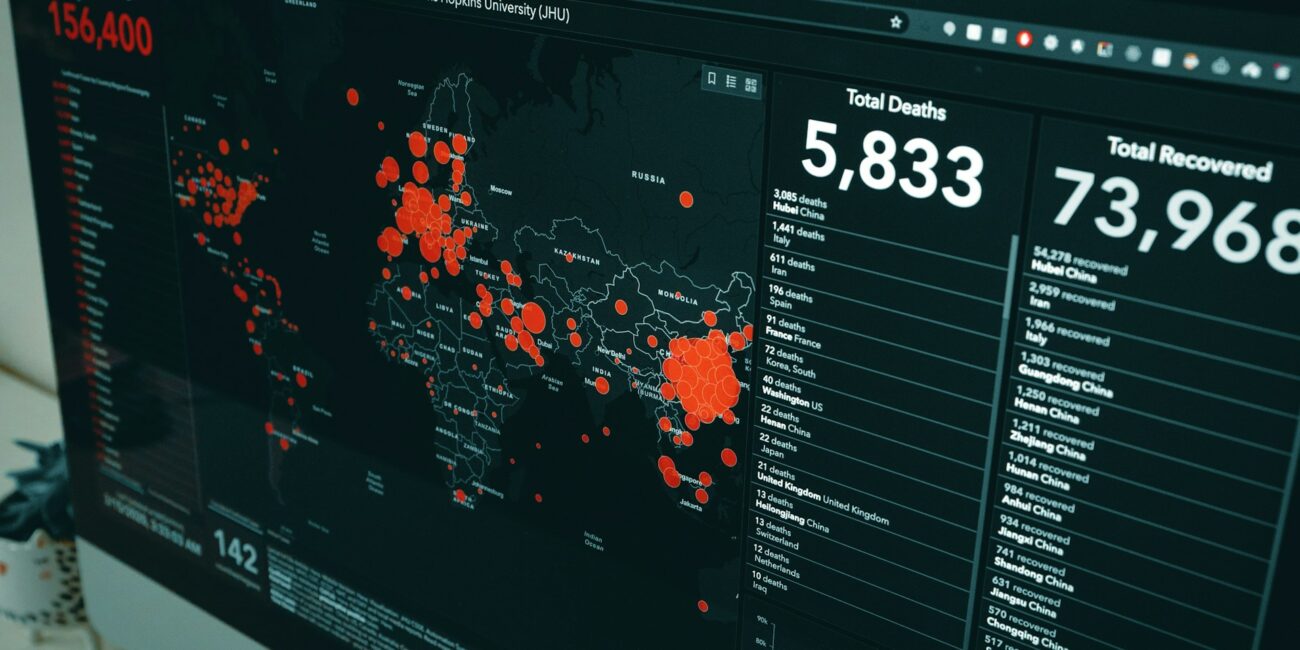Submitted: 16 January 2021
Author: Eric Markhoff*
ABSTRACT
Introduction The lethality of an infection is the most important parameter when deciding how dangerous an agent is (one must decide if you are dealing with a “killer agent”). In order to indirectly assess the lethality of SARS-CoV2, we compared the age distribution of deceased individuals who had been tested positive for SARS-CoV2 during the first wave in 2020 with the age distribution of deaths from the death registers of a previous year (2018 or 2019) for Italy, Germany, France, Spain and England separately for men and women.
Results In all 5 countries the proportion of young deceased (under 70 years of age) was lower among SARS-CoV2-positive deaths than the proportion of young deceased in all deaths in a reference year (2018 or 2019) for men and women. Compared to reference data, the proportion of SARS-CoV2-positive deaths who had reached the age of 80 years before they died was lower in French women and Italian men and women. But it was higher in German men and women, English men and women, French men and Spanish men.
Conclusion SARS-CoV2 is not a “killer virus”.
Background
Respiratory viruses regularly lead to epidemic and pandemic respiratory illnesses. Such respiratory infections can be relatively harmless if they remain constrained to the upper respiratory tract (upper respiratory tract infections), but can also lead to severe, sometimes lethal diseases when reaching the lungs (lower respiratory tract infections) or becoming systemic. Until recently, it was well known and accepted that such viruses commonly occur, (common cold, flu) and it was also known that some people are more vulnerable than others when it comes to severe, potentially fatal infections (older people, people with underlying conditions). Due to the fact that the circulating pathogens, often viruses, were not known and could not be identified by diagnostic means, humans simply accepted the fact that such epidemic respiratory illnesses do exist, do cause disease, and sometimes cause death.
Thanks to progress made in the field of virus-specific diagnostics and diseases surveillance, we are now capable of
- Identifying causal agents of epidemic respiratory illnesses thanks to progress in microbiological diagnostics;
- Detecting epidemics caused by such agents thanks to disease surveillance systems.
Overcoming our “blindness” towards epidemic respiratory illnesses improves our ability to respond to threats in order to decrease morbidity and mortality. However, it has also raised a new dilemma regarding the proportionality of counter-measures. Response measures against epidemic respiratory illnesses come at a price: Social distancing measures, even total shut-downs and curfews might be implemented to reduce the spread of infection. However, shutting down whole societies for several months has unforeseeable negative consequences: many people will lose their jobs or their own businesses and fall into poverty. Many people will either not seek or be denied critical care for serious illness. It is an entirely different matter to know the full extent of the harms lockdowns cause individuals and the mental state of the public as a whole, when time frames substantially exceed a few days or weeks. Effects of social distancing mandates and obligations to wear masks on the individual or collective psyche are other potential mechanisms of harm. Lockdowns cannot be implemented and sustained without threatening the fundamental rights of individuals and peoples to an extent that neutralizes and evens overshadows the claimed benefits. They pose a threat to freedom and democracy.
When a vaccine is developed in an unusually short period of time, potential side effects cannot be explored as vigorously as when the process takes longer. The prospects for those injected with such a vaccine are unknown. This amounts to rolling the dice with respect to outcomes. Taking shortcuts to vaccine development and large-scale implementation only seems justified if the target agent poses an essential threat with a high lethality.
Restricting fundamental rights should remain an “ultima ratio”, if an epidemic respiratory illness poses an existential, potentially disastrous threat to the human population. The reconstitution of fundamental rights has to be assured after the threat is over. Lamentably, the track record of the state making good on such agreements is very poor.
Restriction of fundamental rights as an “ultima ratio” seems justifiable under special circumstances, these are:
- The very early stage of an epidemic respiratory illnesses, when it is still unknown how bad the course of the disease is and further spread can still be limited (the outbreak can still be extinguished);
- Data on the severity of the disease suggest that the disease poses an existential, potentially disastrous threat to the human population.
A guarantee of the full restoration of all rights that existed prior to the declaration of a public health emergency, which is the justification for the suspension of those rights, must be in place before relinquishing those rights for the purpose of dealing with the public health threat.
Once it is impossible to extinguish an outbreak, and the outbreak becomes a large epidemic or pandemic, addressing the second question becomes paramount with respect to justifying “ultima ratio” measures that lead to the limitation of fundamental human rights. How deadly is the spreading pathogen?
How deadly is the newly emerging epidemic respiratory illness?
The most crucial parameter to take into account when considering restrictions of fundamental human rights or lockdown measures, is lethality of an infection and the age distribution of the deceased. Especially in the early phase of a pandemic it is difficult to estimate the lethality of a disease (unless it is causing obvious mass dying such as the black death did in the middle ages).
From early epidemiological data the most important parameters to look for are:
- Age distribution of people deceased with the virus;
- Comorbidity of people deceased with the virus.
The probability of dying in a given year increases with age. The probability of a death with the virus not being attributable to the virus also increases with age and when additional underlying conditions were present.
Consequently, if those who’ve died with the virus lived, on average, beyond the current life expectancy, a large proportion of those individuals who died with the virus did not die of the virus.
Likewise, if those who’ve died with the virus have, on average, more co-morbidities than their corresponding age cohort, a large proportion of those individuals who died with the virus did not die of the virus. (Underlying co-morbidities found in those who’ve died with the virus provide alternative explanations for death, suggesting that a large proportion of individuals who died with the virus did not die of the virus).
If vulnerable groups can be identified, targeted protection of those groups is possible without needing to restrict the fundamental rights of the whole population. Protecting individuals with a high risk for infectious diseases is a well-known concept. For example, bone-marrow transplantation patients are regularly shielded from infectious disease threats.
In this work we compared age distribution in order to indirectly assess the lethality of SARS-CoV2. We compared the age distribution of deceased individuals, who had tested positive for SARS-CoV2 during the first wave in 2020, with the age distribution of deaths from the death registers of a previous year (2018 or 2019) for Italy, Germany, France, Spain and England separately for men and women
Methods: Comparing the age distribution of lethal SARS-CoV-2 cases with demographic data
We compared the age distribution of individuals who died and had tested positive for SARS-CoV-2 during the first wave in 2020 and compared it with the age distribution of deaths from the death register of a previous year (2018 or 2019) for Italy, Germany, France, Spain and England for men and women respectively. Data sources are given under the respective tables.
Results
In Germany, reports on the SARS-CoV-2 pandemic are regularly issued by the Robert Koch Institut (RKI). The distribution of deceased with SARS-Cov-2 positive tests was reported in the “RKI-Lagebericht” on 29 March 2020 for the first time, after one of the authors kindly requested the RKI do so. Shortly before a lockdown was imposed in Germany in mid-March, according to the “RKI-Lagebericht” at 15 March 2020, 12 people had died, however no information about the age of these people was given. The report of the 20 March 2020 counted 31 deceased and provided information about their age. All deceased were older than 65 years, and the median age was 83. Information about severe comorbidities was not included in the RKI’s reporting.
In March 2020, detailed data on the age distribution was available from the “Instituto Superiore Sanita” from Italy accompanied with data on comorbidities. According to the report of 17 March 2020, in Italy 601 women and 1402 men had died with a SARS-Cov-2 positive PCR test. The median age of the deceased women was 83.7, that of the deceased men 79.5 years. Among the 355 deaths for which information on comorbidities was available, only 3 (0,8%) had no comorbidities when they died with a positive SARS-Cov-2 test; 172 (48.5%) had 3 or more comorbidities (comorbidities included ischemic heart disease, atrial fibrillations, apoplexy, arterial hypertension, diabetes mellitus, dementia, COPD, cancer, chronic liver disease and renal insufficiency).
Table 1 shows the age distribution of Italian men who died with a positive SARS-Cov-2 PCR in 2020, as of mid-March 2020. The table compares this age distribution with that of all Italian men who died in 2018. Apparently, the proportion of young deceased (under 70 years of age) was lower (13,8%) among SARS-CoV-2-positive deaths than the proportion of young deceased in all Italian men (21.5. %) who had died in 2018. However, the proportion of Italian men who had reached the age of 80 years before they died was also lower (47.5%) among SARS-CoV-2-positive deaths than the proportion of all Italian men who had reached the age of 80 years before they died in 2018 (54.0 %). A similar pattern could be found in Italian women (Table 2) with 8.6% under-70 deaths among SARS-CoV-2-positive deaths compared to 11.8% under-70 deaths among all Italian women who had died in 2018, but only 64.3% of all SARS-CoV-2-positive Italian female deceased had reached the age of 80 years, compared to 72.8% of all Italian women who had died in 2018.
A similar comparison of the age distribution of SARS-CoV-2-positive deaths with the age distribution of all deceased in a reference year (2018 or 19) was also done for deceased men and women from Germany (Table 3 and 4), France (Table 5 and 6), England (Table 7 and 8) and Spain (Table 9 and 10). In all these countries, consistent with Italy, the proportion of under-70 year old deceased was lower in SARS-CoV-2-positive deaths than in all the deaths in the reference year (Figure 1a and 1b).
In contrast to Italy, the proportion of SARS-CoV-2-positive deaths who had reached the age of 80 years before they died was also higher than this proportion in all deaths in the reference population in German men and women, English men and women, French men and Spanish men (Figures 2a and 2b), but not in French women.
In general, we did not only find fewer young deaths in SARS-CoV-2 positives, but also often more SARS-CoV-2 positive deaths who had lived longer. The age distribution comparison of our five analysed countries leads to the conclusion that SARS-CoV-2 positive deaths had, in general, lived longer than deceased people in a reference year.
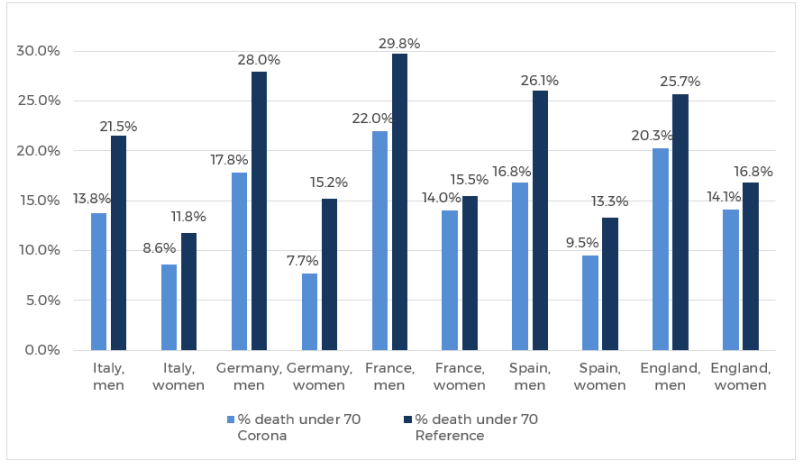
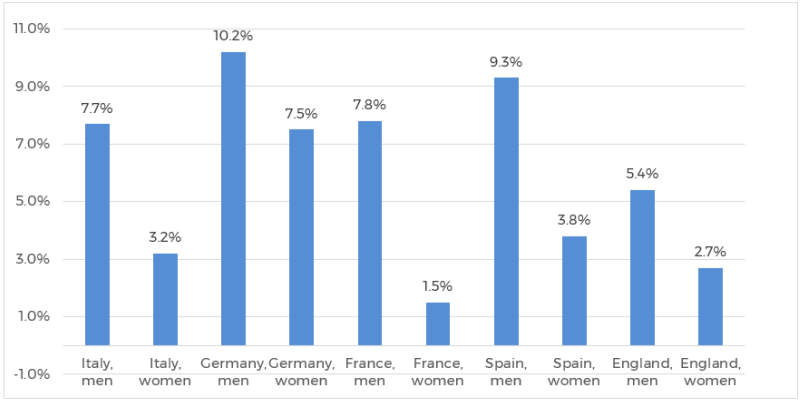
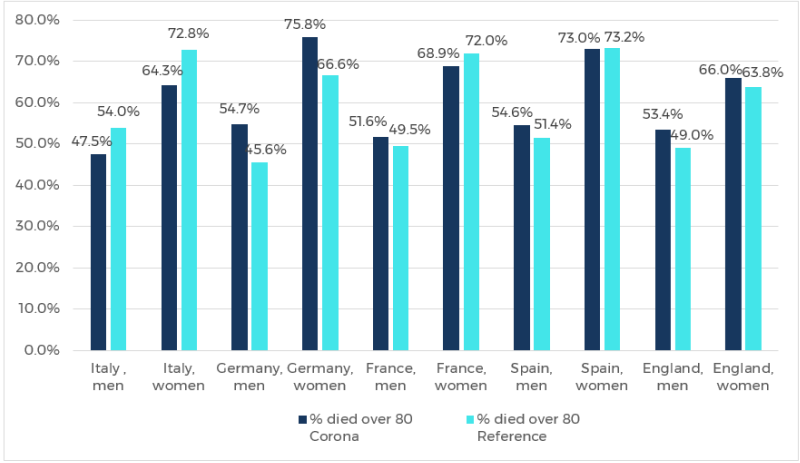
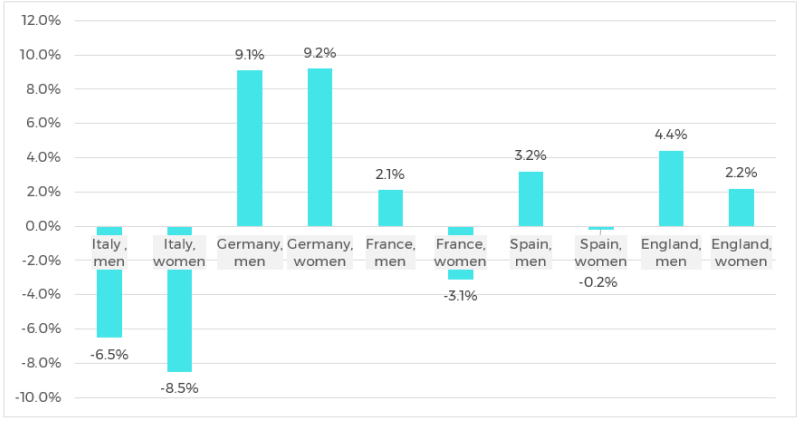
Discussion
Assessing the lethality of an epidemic agent is crucial for assessing the magnitude of the threat in order to curtail appropriate response measures. Our data comparison for Italy, Germany, France, Spain and England showed that those who died with SARS-Cov-2 tended to be older than all those who died in a reference year (2018 or 2019). In none of these 5 countries does our comparison support the perception of SARS-CoV-2 being a highly lethal “killer virus”.
When choosing control measures, potential collateral effects of these measures must be taken into account. Benefits and harms must be balanced with regard to fundamental rights and economic factors, and how claimed benefits and harms may impact health in general, including mental, physical and psychological health.
Control measures must be proportional to the threat. The pandemic wave of SARS-CoV-2 in the European spring of 2020 can hardly be seen as a “killer virus” plague and the rigid control measures taken must be seen as inappropriate overreactions.
Table 1: Comparison of the age distribution of all men who died in Italy in 2018 with the age distribution of men who died in Italy and had been tested positive for SARS-CoV-2 before the 17 March 2020.
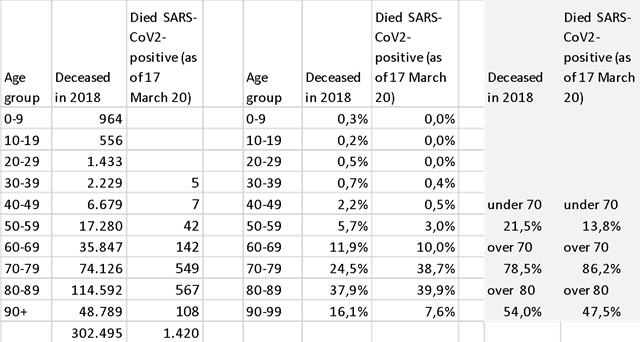
Table 2: Comparison of the age distribution of all women who died in Italy in 2018 with the age distribution of women who died in Italy and had been tested positive for SARS-CoV-2 before the 17 March 2020.

Italia Il presente report è basato sui dati aggiornati al 17 Marzo 2020“ and http://dati.istat.it/Index.aspx?DataSetCode=DCIS_DECESSI
Table 3: Comparison of the age distribution of all men who died in Germany in 2018 with the age distribution of men who died in Germany and had been tested positive for SARS-CoV-2 before the 6 May 2020.

Table 4: Comparison of the age distribution of all women who died in Germany in 2018 with the age distribution of women who died in Germany and had been tested positive for SARS-CoV2 before the 6 May 2020.

Table 5: Comparison of the age distribution of all men who died in France in 2018 with the age distribution of men who died in France and had been tested positive for SARS-CoV-2 before the 26 July 2020.

Table 6: Comparison of the age distribution of all women who died in France in 2018 with the age distribution of women who died in France and had been tested positive for SARS-CoV2 before the 26 July 2020.

Table 7: Comparison of the age distribution of all men who died in England in 2019 with the age distribution of men who died in England and had been tested positive for SARS-CoV2 before the 4 August 2020.

Table 8: Comparison of the age distribution of all women who died in England in 2019 with the age distribution of women who died in England and had been tested positive for SARS-CoV2 before the 4 August 2020.
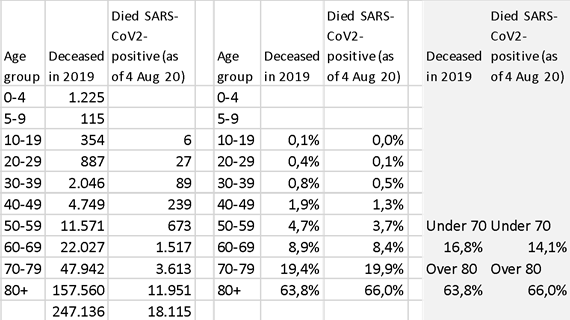
Data Sources: Public Health England: The weekly surveillance report in England and ONS Crown Copyright Reserved [from Nomis on 11 August 2020], Mortality statistics – underlying cause, sex and age, A00-R99,U00-Y89 All causes, all ages.Table 9: Comparison of the age distribution of all men who died in Spain in 2019 with the age distribution of men who died in Spain and had been tested positive for SARS-CoV2 before the 4 August 202.

Data Sources: https://en.wikipedia.org/wiki/COVID-19_pandemic_in_Spain and “Instituto Nacional de Estadística, Movimiento natural de la población. Datos provisionales. Año 2019, Defunciones por edad y sexo, 02001” for the death statistics from 2019.
Table 10: Comparison of the age distribution of all women who died in Spain in 2019 with the age distribution of women who died in Spain and had been tested positive for SARS-CoV2 before the 4 August 2020.
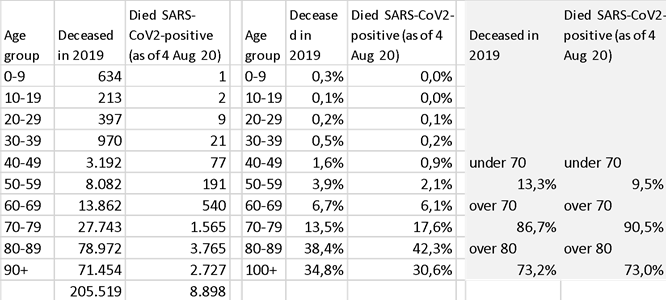
The author is an infectious disease epidemiologist with 20 years of experience, a medical degree, a Masters degree in epidemiology and a Masters degree in medical statistics. He is currently looking for another job as critical assessment of Covid-19 policies seems not to be compatible with the “new normal” in Germany and the rest of the world.
*Pseudonym


